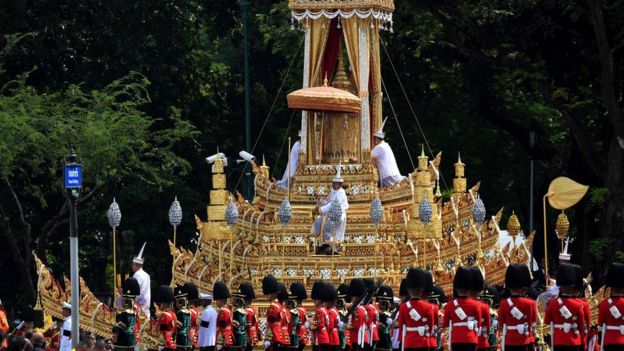Mourners in Thailand are marking the main part of the five-day funeral ceremony for the country’s late King Bhumibol Adulyadej.
The revered king died in October 2016 aged 88.
A series of Buddhist rites began in the royal palace before the royal urn was moved onto a chariot to begin a large procession to the cremation site.
The late king will be cremated later on Thursday, in a royal pyre to be lit by his son, King Maha Vajiralongkorn.
The funeral officially started on Wednesday with a merit-making ceremony, a Buddhist rite, in the Grand Palace.
Many buildings in Bangkok’s old quarter are draped in yellow marigolds, and huge crowds are lining the streets for the funeral procession.

The chariot carrying the urn in the second part of the funeral procession has been used since the late 18th Century. Weighing just under 14 tonne, it is being pulled by more than 200 soldiers.
The elaborate ceremony is estimated to have drawn as many as 250,000 people from across Thailand.
Many of the mourners arrived at the capital days ago, and waited in the streets overnight for the procession, clutching portraits of the late king.
Thursday has been declared a public holiday, with many businesses shut all day or closing at midday.
Members of royal families and dignitaries from more than 40 countries will attend the cremation.
King Vajiralongkorn will light the funeral pyre at 22:00 local time (15:00 GMT) and his father’s ashes will be collected and transported back to the palace on Friday.
Two more days of ceremonies will follow.
The late king was seen as a stabilising figure in a country hit by cycles of political turmoil and multiple coups.
Since his death on 13 October 2016, Thailand has observed a year of official mourning, with many people wearing black.
Preparations for this week’s events took almost a year and have included setting up the large cremation complex near the palace.
The funeral site features sculptures of mythical creatures and auspicious animals such as lions and elephants.
According to Buddhist tradition, the funeral rituals are modelled after the universe and the cremation pyre represents a sacred mountain.
The funeral ceremonies come with strict guidelines for those attending. Thailand’s lese-majeste law, which forbids any insult to the monarchy, is among the harshest in the world.
Roads across Bangkok’s historic centre are shut for the day and while tourists are not expected to wear black like most Thais, they have been asked to dress and behave respectfully.
Source: BBC


Comments are closed.